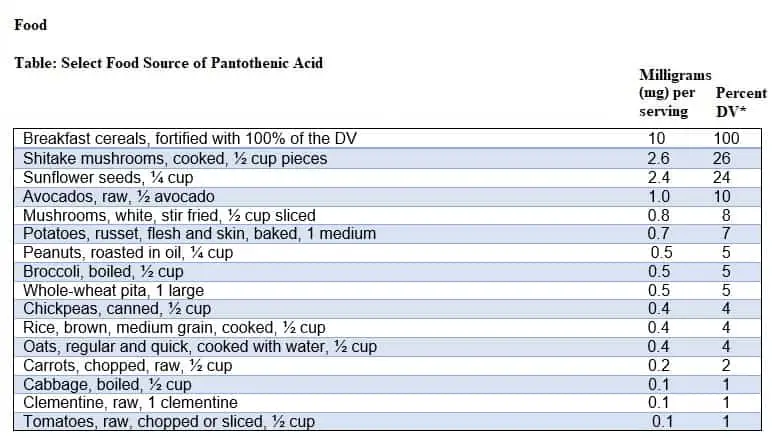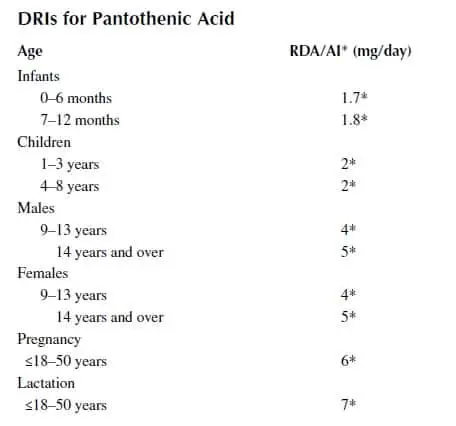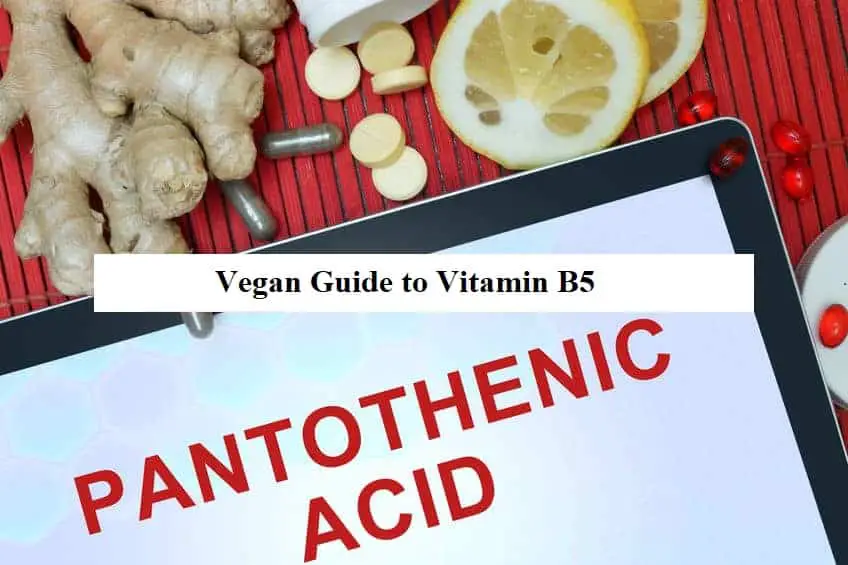What we’ll do here is cover some basic information about pantothenic acid or vitamin B5 as relates to plant-based eating.
First, I’ll answer some common questions for those of you who are in a rush:
- Is vitamin B5 vegan? Yes, unlike vitamin B12 and vitamin D (check out the article here), pantothenic acid is found in numerous plant foods. As for supplements, pantothenic acid can be derived from animals but tends to be produced via chemical synthesis.18 So, it’s typically considered vegan.
- What are some vegan sources of vitamin B5? Breakfast cereals, shitake mushrooms, sunflower seeds, and avocados are among the best plant sources of pantothenic acid.1 (See the chart below for more examples)
- Are vegans commonly deficient in vitamin B5? No. According to NIH, the only group at risk for pantothenic acid deficiency are people with a pantothenate kinase-associated neurodegeneration 2 mutation.1
So, let’s take a closer look at the sources of pantothenic acid as well as some other basic info.
Overview and Functions
Pantothenic acid was discovered in 1933 but wasn’t known to be essential until 1954.2 Structurally, pantothenic acid consists of the amino acid β-alanine and pantoic acid which are joined by an amide linkage/peptide bond. Don’t worry, you don’t need to know that.
If you’ve read the articles on thiamin, riboflavin, and niacin, then you know by now that B vitamins tend to be coenzymes. P
As for vitamin B5’s roles, the short answer is that it functions in acylation reactions, hence the “A” in coenzyme A. It carries out this function as part of acetyl-CoA and acyl carrier protein.4
Coenzyme A
Nutrient Metabolism
Catabolic Reactions
Like other B vitamins, pantothenic acid plays a role in nutrient degradation reactions for energy production. The metabolism of fats, carbs, and protein all rely to varying degrees on CoA. After all, acetyl-CoA is the compound formed from all three energy-producing nutrients, thus holding the central position in energy transformation.
For example, CoA is used in the conversion of pyruvate to acetyl-CoA, which provides carbon for the Krebs cycle. It also participates in the oxidative decarboxylation of other TCA cycle intermediates.
Biosynthesis
B5 takes part in several synthetic reactions for the production of many vital compounds. So, in addition to pantothenic acid’s role in nutrient catabolism, CoA is used in synthetic reactions to produce a number of vital compounds.
For example, pantothenic acid (as CoA) is used in the synthesis of:5
- Fatty acids—the first step in FA synthesis is the condensation of acetyl-CoA with activated CO2 to make malonyl-CoA.
- Cholesterol and ketone bodies—CoA is used to form the key intermediate HMG-CoA.
- Bile salts
- Steroid hormones
- Phospholipids and sphingomyelins
- Heme (indirectly)
In helping form succinyl-CoA (TCA intermediate), the compound can go on to react with glycine to make heme.
Acetylation of Proteins and Other Compounds
Acetylation is just the donation of acetate or long-chain fatty acids. CoA is involved in the acetylation of some sugars and proteins as well as certain drugs.
These reactions accomplish a number of things:5
- Activating an enzyme, or deactivating one.
- Prolonging the half-life of a protein or peptide.
- Converting choline to acetylcholine (a neurotransmitter).
- Forming compounds from aminosugars (glucosamine and galactosamine, etc.) for cell recognition sites, among other functions.
Acyl Carrier Protein (ACP)
As part of 4′-phosphopantetheine, pantothenic acid also functions in acyl carrier protein in the fatty acid synthase complex. So, pantothenic acid contributes directly to fatty acid synthesis.5
Vegan Sources of Vitamin B5
Pantothenic acid is found in a variety of foods. The Daily Value for pantothenic acid is 10 mg. In supplements, pantothenic acid is usually found as calcium pantothenate or as panthenol, an alcohol form of the vitamin.
In the US, most adults consume around 4 to 7 mg of pantothenic acid per day. The vitamin is destroyed easily by both heating and freezing. As for acidity, it’s stable at a neutral pH when dry and in solution but is easily destroyed in acidic and alkaline solutions. The refining process grains undergo decreases their vitamin B5 content by as much as 75% which is why most grains are enriched.
Legumes and Whole Grains
Grain products (general)—whole, fortified or enriched:6
- Cereals— 3/4 Cup of NutriGrain® provides about 10 mg which is 100% of the Daily Value.6
- Lentils—1 Cup provides 1.3 mg or 13% DV.7
Vegetables
- Broccoli—1 cup has 0.5 mg or 5% DV.8
- Mushrooms (not technically a vegetable)—1 Cup has 1.3 mg (13% DV).9
- Tangentially, mushrooms are also a rare source of plant-based vitamin D.
- Avocados (also not a vegetable)—1 Cup has 2.1 mg or 21% DV.10
- Potatoes—1 large potato has 1.1 mg or 11% DV.11
Select Vegan Pantothenic acid Sources

Source: adapted from Office Of Dietary Supplements – Pantothenic acid https://ods.od.nih.gov/factsheets/Pantothenic acid-HealthProfessional/
These values were based on the current DV for pantothenic acid which is 10 mg for adults and children 4 years of age and older.12
This DV is actually changing to 5 mg per the updated Nutrition and Supplement Facts labels.13
The updated values can be used now, but the updated labels aren’t mandatory on supplements and food products until January 2020.14
The FDA doesn’t require food labels to list vitamin B5 content unless a food product has been fortified with it. A food is considered a high source of pantothenic acid if it provides 20% or more of the DV, but foods providing less than this amount still contribute to a healthful diet.
The U.S. Department of Agriculture’s (USDA’s) National Nutrient Database external link disclaimer has a comprehensive list of foods and their nutrients (including pantothenic acid) that’s arranged by nutrient content.”17
Vegan Needs (Adequate Intake)
Because bioavailability isn’t an issue, vegans have the same needs as the rest of the population.
The AI for pantothenic acid intake is 5 mg for both men and women.15Needs go up a bit for pregnancy and lactation increasing to 6 mg/day and 7 mg/day, respectively.15

Source: Micronutrients in Health and Disease. Kedar Prasad – Crc – 2011
Deficiency Symptoms
A condition known as burning feet syndrome is associated with pantothenic acid deficiency and is characterized by numbness of the toes and a sensation of burning in the feet.
How do they know it’s caused by pantothenic acid deficiency? Researchers used a metabolic inhibitor of pantothenic acid, called omega
It’s diminished by cold and exacerbated by warmth and has a number of other symptoms that often accompany it:16
- Weakness and fatigue
- Vomiting
- Restlessness
- Irritability
As with other B vitamins, pantothenic acid deficiency is thought to occur more readily in conjunction with other nutrient deficiencies, as in undernutrition. There are various conditions that are known to increase the need for B5 which include:16
- Diabetes mellitus—increased excretion of the vitamin is often observed in folks with DM.
- Alcoholism—this may simply be due to poor vitamin intake in those who abuse alcohol.
- Inflammatory bowel diseases—it likely impairs absorption of the vitamin.
The Vegan Diet and Pantothenic Acid Status
Luckily, we don’t have to worry about pantothenic acid deficiency, as the nutrient is ubiquitous in plant foods. The prefix for pantothenic is pantos which is Greek for “everywhere.” As the name implies, p
For this reason, deficiency is very unlikely even on restrictive diets. In supplements, pantothenic acid is usually found as panthenol (an alcohol form of the vitamin) or calcium pantothenate, both of which are typically vegan.
References
- Office Of Dietary Supplements – Pantothenic Acid https://ods.od.nih.gov/factsheets/PantothenicAcid-HealthProfessional/
- Richards, Oscar W. (1938). “The Stimulation of Yeast Proliferation By Pantothenic Acid” (PDF). Journal of Biological Chemistry. 113 (2): 531–536.
- Jencks, W. P.; Wolfenden, R. V. (2000). “Fritz Albert Lipmann. 12 June 1899 — 24 July 1986: Elected For.Mem.R.S. 1962”. Biographical Memoirs of Fellows of the Royal Society. 46: 333. doi:10.1098/rsbm.1999.0088
- Gropper, Sareen S.; Smith, Jack L.. Advanced Nutrition and Human Metabolism (Page 334).
- Gropper, Sareen S.; Smith, Jack L.. Advanced Nutrition and Human Metabolism (Page 337).
- Cereals Ready-to-eat, General Mills, Whole Grain Total Nutrition Facts & Calories https://nutritiondata.self.com/facts/breakfast-cereals/1557/2
- Lentils, Mature Seeds, Cooked, Boiled, Without Salt Nutrition Facts & Calories https://nutritiondata.self.com/facts/legumes-and-legume-products/4338/2
- Broccoli, Raw Nutrition Facts & Calories https://nutritiondata.self.com/facts/vegetables-and-vegetable-products/2356/2
- Mushrooms, Portabella, Raw [portabello] Nutrition Facts & Calories https://nutritiondata.self.com/facts/vegetables-and-vegetable-products/2485/2
- Avocados, Raw, All Commercial Varieties Nutrition Facts & Calories https://nutritiondata.self.com/facts/fruits-and-fruit-juices/1843/2
- Potato, Flesh and Skin, Raw Nutrition Facts & Calories https://nutritiondata.self.com/facts/vegetables-and-vegetable-products/2546/2
- U.S. Food and Drug Administration. Guidance for Industry: A Food Labeling Guide external link disclaimer(14. Appendix F: Calculate the Percent Daily Value for the Appropriate Nutrients). 2013.
- U.S. Food and Drug Administration. Food Labeling: Revision of the Nutrition and Supplement Facts Labels.external link disclaimer 2016.
- U.S. Food and Drug Administration. Food Labeling: Revision of the Nutrition and Supplement Facts Labels and Serving Sizes of Foods That Can Reasonably Be Consumed at One Eating Occasionexternal link disclaimer; Dual-Column Labeling; Updating, Modifying, and Establishing Certain Reference Amounts Customarily Consumed; Serving Size for Breath Mints; and Technical Amendments; Proposed Extension of Compliance Dates. 2017.Robishaw J, Neely J. Coenzyme A metabolism. Am J Physiol. 1985; 248:E1–9.
- Robishaw J, Neely J. Coenzyme A metabolism. Am J Physiol. 1985; 248:E1–9.
- Gropper, Sareen S.; Smith, Jack L.. Advanced Nutrition and Human Metabolism (Page 338).
- U.S. Department of Agriculture, Agricultural Research Service. USDA National Nutrient Database for Standard Reference, Release 28. external link disclaimerNutrient Data Laboratory Home Page, 2015.
- Jose L. Revuelta, Ruben M. Buey, Rodrigo Ledesma‐Amaro, and Erick J. Microbial biotechnology for the synthesis of (pro)vitamins, biopigments and antioxidants: challenges and opportunities. Microb Biotechnol. 2016 Sep; 9(5): 564–567.


